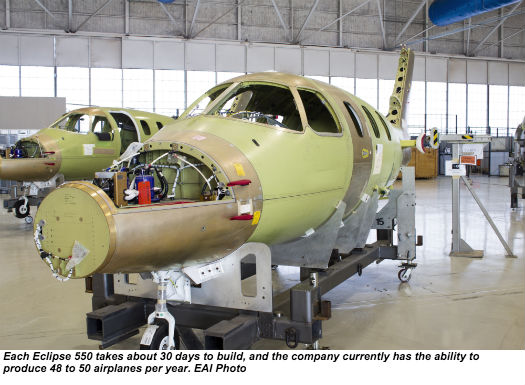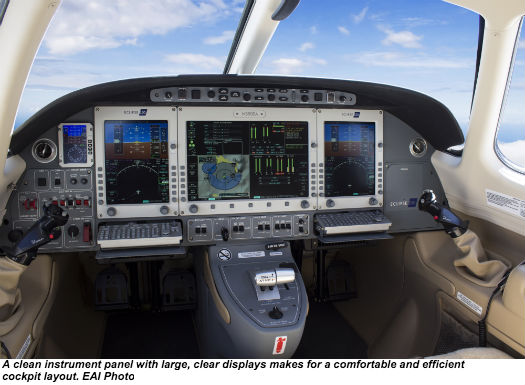The Phoenix is a mythological bird that dies by fire, yet rises from the ashes to be reborn. Some might say that the new Eclipse 550 jet is the Phoenix of the aviation industry. Indeed, it traces its roots to Eclipse Aviation of Albuquerque, N.M., which virtually invented the very light jet (VLJ) category when it delivered the first Eclipse 500 (EA500) in January 2007.
Yet, in what some called the greatest financial failure in aviation history, Eclipse Aviation declared bankruptcy in November 2008. Less than a year later, however, the company re-opened for business under the new name of Eclipse Aerospace Inc. (EAI). Although the names are similar, the born-again Eclipse is quite different, with new owners, new goals, and even a somewhat new logo. Many of the faces are familiar, however, with nearly 80 per cent of EAI’s employees being previous employees of Eclipse Aviation, and returning to their jobs at the new company. Skies recently visited the EAI facility in Albuquerque, where it was clear that employees are genuinely proud of the company and the work they do.
After re-opening, EAI staff initially focused on upgrading the roughly 260 EA 500 aircraft in operation with the flight into known icing (FIKI) and Avio integrated flight management system (IFMS) equipment that had been promised by the previous company. Today, that goal is close to complete. “Approximately 93 per cent of the existing fleet has now been upgraded to Avio version 1.5 or greater,” reported Ken Ross, EAI president of global sales and service.
RETURN TO PRODUCTION
After several years of cautious optimism backed by a new partnership and support from Sikorsky Aircraft, a decision was made to re-open the production line. EAI delivered its first new jet, now called the Eclipse 550, in March 2014.
From the outside, the 550 looks exactly like the earlier 500 models—but in fact, the new airplane has been substantially upgraded. Auto throttles, anti-skid brakes, a new interior, synthetic vision and enhanced vision are just a few of the features added to the Eclipse 550.
There are actually two ways to buy an Eclipse jet. The obvious scenario involves purchasing a new 550 model for US$2.895 million, but the less expensive option is through EAI’s “Total Eclipse” (TE) program. This program delivers significant savings through substantially upgraded, pre-owned EA 500 models that are offered for US$2.25 million.
According to Ross, “All TE aircraft are fully enrolled in the Pratt & Whitney Gold ESP (Eagle Service Plan), completed with new interiors and paint, and are sold with one pilot type rating and a one-year factory warranty. For the customer, they are receiving a like-new aircraft with many of the latest features offered by the company.”
Regardless of the purchase plan, owners get a 375-knot true airspeed airplane capable of flying above the weather at FL410, burning between 48 and 59 gallons of fuel per hour.
The addition of auto throttles makes the Eclipse 550 the only airplane in its class with this feature.
“Our goal is to reduce the workload for single-pilot operations,” commented Eclipse’s director of flight test, Jerry Chambers. Activated shortly after takeoff, the workload reduction delivered by the auto throttles is substantial, thereby greatly enhancing safety. The new anti-skid braking system allows for maximum control on landing and has been proven to stop the airplane in 700 feet under normal touchdown speeds.
The addition of synthetic vision and enhanced vision options further emphasizes the company’s commitment to safety. Synthetic vision creates a 3D image of the flying environment and displays any terrain or obstacles that may present a hazard on the Avio displays. The enhanced vision system takes this a step further by utilizing a forward-looking infrared sensor mounted in the nose, allowing a pilot to see the runway in a reduced-visibility environment such as low IFR or night.
EAI has also upgraded its training program. Previously, all pilot training was conducted in-house, with two FAA Level D-certified simulators and flight training conducted in the Albuquerque area. While Eclipse still owns both simulators, they are now operated by SimCom in Orlando, Fla., for initial training.
MILITARY DESIGNS
One unique market Eclipse is exploring is military training. The key to opening up this opportunity is convincing the U.S. Air Force to replace its fleet of Beechcraft T-1A Jayhawk advanced trainers with new Eclipse 550s.
“The T-1 is a 30-year-old design with steam gauges and it is costly to operate. We offer glass cockpit technology, enhanced safety features, and greatly reduced acquisition and operating costs,” said Ed Lundeen, EAI’s senior vice president of business operations.
While not exactly a direct comparison, the Eclipse 550 does appear to offer a substantial upgrade in capability for the Air Force’s training mission, and the fuel savings alone would be dramatic. “We’ve had interest from other militaries and we believe a successful deal with the Air Force would make a difference,” added Lundeen.
Recent analyses of the business jet market illustrate the daunting challenge for Eclipse. While the large cabin size segment of the industry has fared quite well, smaller cabin jet sales are trending downward.
According to Lundeen, however, interest in the Eclipse 550 is steadily increasing, leading to optimism for the future. Success for Eclipse lies in exploiting a unique target market. Ken Ross elaborated: “I would say that we have two main groups of customers that use the Eclipse: the owner/pilot and the passenger. For the former, many of them are individuals who are stepping up from Cirrus SR22s, Piper Meridians, Daher-Socata TBMs, the Beechcraft King Air, or other high performance twin-engine piston and turboprop aircraft. The second group, the passengers, includes individuals who sit in the back and have a professional crew. They are usually business owners, CEOs, or senior executives that clearly see the economic advantage in operating and using the world’s most efficient light jet.”
While challenges certainly lie ahead, it’s clear that Eclipse Aerospace has risen from the ashes and has been reborn with a new vision. The company’s Eclipse 550 is a small business jet packed with substantial features, delivering a high level of safety, ease of operation, and a sound economic proposition. Ultimately, the market will be the deciding factor, but Eclipse has positioned itself favourably for a successful future.
Mike McKinney is a frequent contributor to Skies’ sister magazine, Vertical, and spent 20 years as a USAF special operations pilot, flying the Bell UH-1N Twin Huey, Sikorsky MH-53J/M Pave Low III, and the Bell Boeing CV-22B Osprey. Presently, he works as a maintenance test pilot for the U.S. government.







